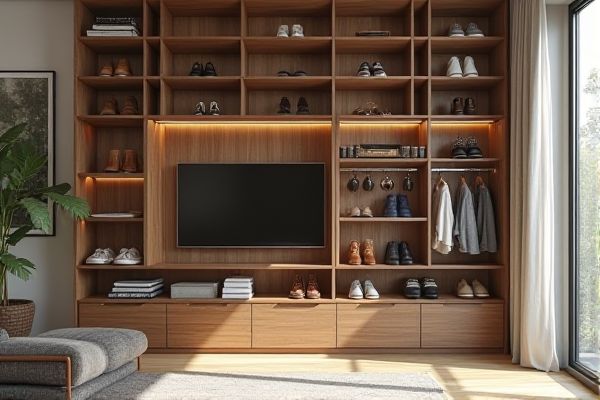
Choosing between a shoe rack and a shoe cabinet depends on your space, storage needs, and aesthetic preferences, with shoe racks offering open, easy access and shoe cabinets providing concealed, dust-free organization. Explore the rest of the article to discover which option best suits your home and lifestyle.
Table of Comparison
| Feature | Shoe Rack | Shoe Cabinet |
|---|---|---|
| Design | Open shelves for shoe display | Enclosed compartments with doors |
| Storage Capacity | Holds 6-12 pairs, depending on size | Holds 12-30+ pairs, efficient vertical storage |
| Space Efficiency | Compact but visible storage | Space-saving, hides clutter |
| Protection | Minimal protection from dust | Protects shoes from dust and damage |
| Material | Commonly wood, metal, plastic | Often wood, MDF, laminate, metal |
| Cost | Generally lower price | Typically higher price due to design |
| Accessibility | Quick and easy access to shoes | Shoes may require door opening |
| Ideal Usage | Casual storage, easy organization | Formal storage, neat and organized |
Introduction to Shoe Racks and Shoe Cabinets
Shoe racks offer open shelving designed for easy access and ventilation, making them ideal for frequently worn footwear and quick storage solutions. Shoe cabinets provide enclosed storage with doors or drawers, helping to protect shoes from dust and maintain a tidy appearance in entryways or closets. Choosing between a shoe rack and a shoe cabinet depends on space availability, desired aesthetic, and organizational needs.
Key Differences: Shoe Rack vs Shoe Cabinet
A shoe rack typically features open shelves that provide easy access and ventilation for your footwear, while a shoe cabinet offers enclosed storage that protects shoes from dust and creates a tidier appearance. Shoe racks are lightweight and often portable, making them ideal for casual or temporary arrangements, whereas shoe cabinets are sturdier with doors or drawers, suited for long-term organization. Your choice depends on whether you prioritize visibility and breathability or a sleek, concealed storage solution.
Space Efficiency: Which One Wins?
Shoe cabinets offer superior space efficiency by maximizing vertical storage with multiple enclosed shelves, making them ideal for small entryways or tight spaces. Shoe racks, while often more versatile and easier to access, tend to occupy more floor space and lack the compact organization of cabinets. For optimizing limited areas, shoe cabinets ultimately provide better containment and a tidier footprint.
Storage Capacity Comparison
A shoe rack typically offers open, tiered shelving that accommodates a larger number of shoes with easy visibility and access but occupies more horizontal space. A shoe cabinet provides enclosed compartments, protecting footwear from dust while often limiting capacity due to individual enclosed slots. Selecting between the two depends on balancing maximum shoe storage needs against space availability and protection preferences.
Design and Aesthetic Appeal
Shoe racks offer an open design that showcases footwear for easy access and ventilation, ideal for casual or minimalist spaces. In contrast, shoe cabinets provide a sleek, enclosed structure that hides shoes from view, enhancing a room's tidy and sophisticated appearance. Choosing between the two depends on whether visibility or a streamlined aesthetic is prioritized in home decor.
Material and Durability
Shoe racks are often made of lightweight materials like metal or plastic, offering easy portability but less durability compared to shoe cabinets, which are typically constructed from sturdier woods or MDF materials designed for long-lasting use. Cabinets provide better protection from dust and damage, ensuring your shoes remain in pristine condition over time. Your choice between a shoe rack and a shoe cabinet will depend on whether you prioritize lightweight convenience or robust storage durability.
Maintenance and Cleaning Tips
Shoe racks typically require less maintenance due to their open design, allowing for easy dusting and air circulation that prevents odor buildup. Shoe cabinets, however, need regular cleaning inside and out to avoid dust accumulation and must be wiped down to maintain their polished finish. You can extend the lifespan of both by promptly addressing spills and using appropriate cleaning products for the materials, such as wood polish for cabinets and mild soap for metal racks.
Price and Budget Considerations
Shoe racks generally offer a more budget-friendly option compared to shoe cabinets, making them ideal for those seeking cost-effective storage solutions. You can find a variety of shoe racks available at lower price points, whereas shoe cabinets often involve higher investments due to their enclosed design and additional features. Evaluating your budget alongside storage needs will help determine whether a shoe rack or shoe cabinet fits your financial plan.
Choosing the Right Option for Your Home
When choosing between a shoe rack and a shoe cabinet for your home, consider the available space and storage needs. A shoe rack offers open visibility and quick access, ideal for smaller areas and frequently used footwear, while a shoe cabinet provides concealed storage, helping maintain a tidy and organized look. Your decision should balance convenience, style, and the volume of shoes you own.
Conclusion: Shoe Rack or Shoe Cabinet?
Choosing between a shoe rack and a shoe cabinet depends on available space and organization preferences. Shoe racks offer open storage with quick access and breathability, ideal for casual use and larger collections. Shoe cabinets provide concealed storage with a tidy appearance, perfect for smaller spaces and maintaining a clutter-free environment.
 homyna.com
homyna.com